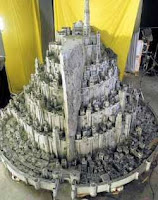Pyrotechnics is common to use in conjunction with model miniatures to create the illusion of buildings blowing up and alike. It involves using explosives to mimic the effects of things like bombs, and there are certain ways in which model miniatures have to be constructed in order to get the dramatic results we see on tv. Firstly models used for this type of action shoot need to be built as big as possible. Frequently and so that the model will explode more easily they get made in sections which are simply laid into position.
Lots of dust and debris needs to be provided at the source of the explosion. One method is the use of cement dust which can be blown out using compressed air.
Wednesday, 29 October 2008
'Bigatures'
Sometimes films require more than small scale miniatures in order to make certain special effects look convincing on camera. One of the biggest problems with miniatures is that they can't effectively simulate things like weight and gravitational pull. There is also a big problem when water comes into play. If for example you want to drown a model miniature of a building that has been built at 1:50 scale, the size of the droplets are going to come across on camera as being enlarged. One way to deal with this problem is to build giant miniatures.
This was the method used for filming certain scenes in Titanic that required a lot of action with water. One of the larger models was built at 45 feet long!
Another film that utilised these 'bigatures' was The Lord of the Rings. WETA workshop that worked on the film made huge miniatures of some of the locations, like the one below, with a very high level of detail. This was because they couldn't create the locations in a full size set and they didn't want to opt for CGI for various reasons.

Sunday, 19 October 2008
Filming Miniature Models
Filming miniature models can be make or break when it comes down to how successful they look on camera. A model can be very well made but can still look unbelievable if it isn't filmed in the correct way. This all comes down to scale, depth of field and camera speed.

- Depth of field: To make miniatures look realistic it is important to photograph them with the same depth of field as would be used in normal scale photography. This will usually involve having to get quite close to the model, but making sure that both the model and the background are in focus. For example if you filmed a normal sized car from a length of 3 metres, the car and the majority of the background would be in focus. To re-crete this depth of field on a 1:10 scale model car you would need to film the model nine tenths closer, so only 30cm away.
A couple of months ago I came across a process called Tilt-Shift photography, which is a perfect example of how important depth of field can be in relation to creating the illusion of scale. The Tilt-Shift process involves manipulating photographs of life sized objects or locations to make them look as though they are miniature scale models. Click on the link below to have a look at the results and some examples of this technique. http://www.tiltshiftphotography.net/
Saturday, 11 October 2008
Intro
I've created this blog as an addition to my external brief project, for which I have to make a model miniature of a lighthouse. Due to the fact that this is a course project I am subject to certain limitations when it comes to building the model. In industry it would be built in a way that it could be filmed as a distance shot, and would have CGI added to it in post production. The model would also need to be destroyed on camera in order to create the special effects needed for the film it would hypothetically be used in.
As I won't be able to carry out all of this for my project I'm dedicating this site into researching how the television and film industry construct model miniatures for the purpose of special effects.
Click the link to go to my external brief blog and learn more about my project and the progress I'm making on my model. http://www.sophieyoulden.blogspot.com/
Subscribe to:
Posts (Atom)

